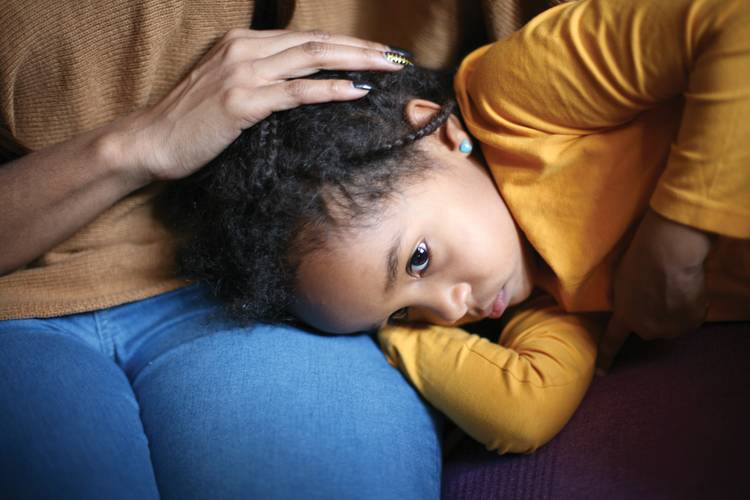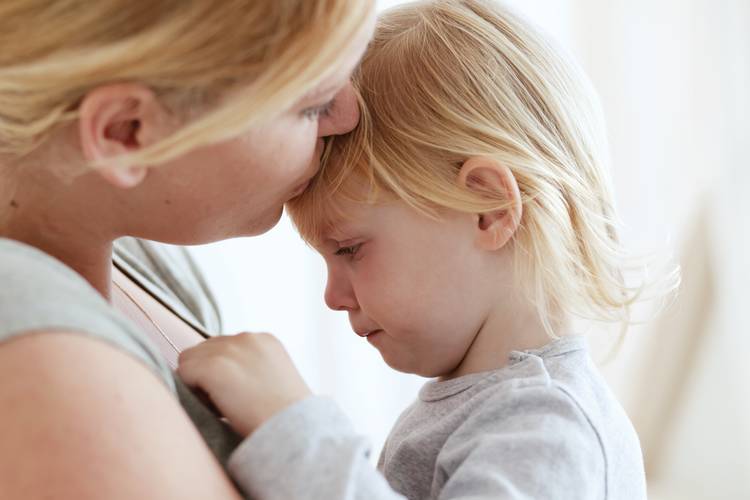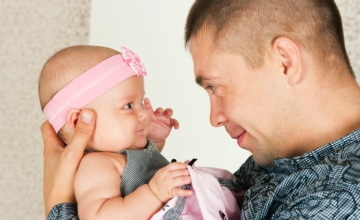Elesia N. Hines and Shannon L. Thompson, Indiana University
Michelle B. Moore, Amy B. Dickson, and Kristin L. Callahan, Louisiana State University Health Sciences Center, New Orleans, Louisiana

Abstract
Decades of research and clinical observations have demonstrated the harmful effects of parent–child separation on children’s short- and long-term well-being (Society for Research in Child Development, 2018). Young children may be separated from their parents due to a variety of circumstances. This article provides recommendations for the assessment, diagnosis, and treatment of young children who experience trauma as a result of being separated from their parent due to incarceration. An example of a multidisciplinary health care clinic is highlighted to demonstrate how clinicians and community partners work together to provide evaluation and care coordination services for children in foster care.
Being separated from a parent can have devastating effects on a young child. Even in necessary conditions (e.g., removal from a parent due to maltreatment), separating children from their parents is an adverse childhood experience that poses certain risks to the child, including trauma and toxic stress (Mackenzie, Bosk, & Zeanah, 2017; Miller, 2006). Young children especially rely on their parents to act as a buffer during stressful times. Thus, when a child is separated from their parent, the child experiences a high level of stress but has lost the protection provided by the attachment relationship. Behavioral challenges and emotional problems, including anxiety, depression, and symptoms of posttraumatic stress disorder may arise. Experiencing chronic stress and trauma as a young child can also have an impact on brain development and cause prolonged activation of the body’s stress response system (Shonkoff et al., 2012).
Circumstances under which children experience parental incarceration vary greatly; therefore, understanding the context of the incarceration is extremely important. Even before the parent is incarcerated, the arrest of the parent can cause children to be traumatized, as they are often shocked, confused, and frightened by the experience. Arrests happen spontaneously and can look violent to a young child. There may be yelling, crying, and distress on the part of the caregivers, who are often focused on the arrested parent and not on shielding the young child from the arrest. In the immediate aftermath of the event, young children may remain unattended to emotionally, and at times physically, as the remaining adults seek to understand what has just happened and what to do next (Lieberman & Bucio, 2018). Determining what the child actively experienced (e.g., what they heard and saw during the arrest) or did not experience (e.g., having a parent removed from the home out of sight of the child) is clinically relevant.
Parental incarceration causes numerous losses for a young child, far more than just the experience of missing a parent. Following an incarceration, families are often strained financially (Wakefield & Wildeman, 2018). The incarcerated parent may have been a single parent, resulting in the child being abruptly placed out of their home, perhaps with caregivers not well known to the child, or a complete stranger such as a foster parent. It is often difficult for a young child to maintain a relationship with their incarcerated parent. Sometimes the arrested parent is imprisoned at a distance too far for the family to travel. Visitations with the parent may require a full day of travel for the child, and often prisons are scary places for young children. Children may wait for long periods of time in less-than-ideal crowded settings not conducive to play or nurturing care, only to see their parent for just a short time and often through glass. When visitation is not possible, the parent may be permitted to make phone calls, but young children often have difficulty connecting with their caregiver over the telephone. Hence the bond with the incarcerated parent is abruptly disrupted. Very young children have not yet achieved object permanence, which leads to a true loss of the relationship as the child does not remember the incarcerated parent over time. Abrupt loss of one caregiver can lead the child to have constant anxiety that other caregivers will suddenly disappear. This anxiety can cause insecure attachment in young children (Briggs-Gowan et al., 2019; Parke & Clarke-Stewart, 2001) and difficulty bonding to the caregiver upon their release from prison or to bonding with their current caregiver.
Children who have developed focused or selective attachment, meaning they have developed a special preference for a single attachment figure (Weinfield, Sroufe, Egeland, & Carlson, 2008), remember their parents and are confused by the loss, grieving the missing parent and wondering what happened to them. Depending on the child’s developmental level and lack of familial transparency regarding the arrest and incarceration, the child may feel that the parent abandoned them or that they caused their parent’s absence. This traumatic experience can result in depression, clinginess, new fears, and regression in behaviors. The child may be placed with a caregiver who does not mention the missing parent, as members of many cultures experience shame when a family member is incarcerated. In essence, it is as if the caregiver is truly gone due to both the physical loss as well as the lack of any acknowledgment about the caregiver for the child. This loss is compounded when the remaining caregiver does not recognize the emotional impact on the child. Homes in which a parent becomes incarcerated are often already multiply stressed and cannot afford more disruption. Young children require stability, consistency, and a sense of felt safety to grow and thrive, and parental incarceration disrupts all of these to the child’s detriment.
Clinical Assessment of Trauma in Young Children
Children who have been separated from their parent due to incarceration may come to the attention of mental health clinicians or medical providers when they display challenging or alarming behaviors in their new home or in an early childhood program. In some clinical settings, it will be appropriate to implement a standard battery of developmental and trauma-specific screening tools to assess the child and caregiver’s functioning at intake. When needed, further comprehensive diagnostic assessment can help clarify complex trauma presentations based on children’s unique symptomatology and history and inform developmentally appropriate interventions embedded in the family’s social and attachment frameworks.
Children of incarcerated parents often have multiple, stressful life events before parental incarceration (Poehlmann-Tynan, Burnson, Runion, & Weymouth, 2017). Therefore, in addition to obtaining general background information, clinicians should gather infor-mation related to the child’s prior living arrangements, the child’s age at the time of incarceration, the quality of the parent–child relationship before incarceration, and family economic resources. Clinicians should also inquire about the context surrounding the incarceration including the nature and length of the sentence, access to alternative child care, contact with the incarcerated parent, how other family members are coping, and their wider social context (Parke & Clarke-Stewart, 2001).
Assessing Development, Behavior, and Social–Emotional Functioning
Assessment tools that evaluate a broader range of a child’s developmental abilities can be helpful to determine any delays that need to be considered in formulating interventions and future planning. Evaluating a child’s developmental level and unique strengths and challenges are essential for understanding how that child may be able to interpret, understand, and assimilate the context of parental incarceration. When selecting tools, clinicians should consider their appropriateness for the child and family’s culture. The Ages & Stages Questionnaires, Third Edition (Squires, Bricker, & Potter, 2009) is a common caregiver-completed developmental screening tool that identifies young children with developmental delays. If this screener indicates developmental areas of concern, the Bayley Scales of Infant and Toddler Development, Fourth Edition (Bayley & Aylward, 2019) and the Mullen Scales of Early Learning (Mullen, 1995) are more comprehensive developmental assessments to assess broader cognitive, language, and motor abilities, but clinicians need more specialized training to administer such measures.

Parental incarceration causes numerous losses for a young child, far more than just the experience of missing a parent.
Broad measures of behavioral and emotional symptoms can be used to inform clinicians when further assessment of significant symptomatology may be needed. Examples of such rating scales include the Behavior Assessment System for Children, Third Edition (Reynolds & Kamphaus, 2015), Devereux Early Childhood Assessment (LeBuffe & Naglieri, 1999), and Child Behavior Checklist (Achenbach & Rescorla, 2000), all of which can be completed by a caregiver. Results of standardized tools that assess behavioral and emotional symptoms should be interpreted in light of the traumatic event and the child’s developmental level to carefully pull apart the outward displays of distress including withdrawal, irritability, aggression, inattention, and hyperactivity. More specific early childhood mental health assessment tools that evaluate the impact of trauma include the Spence Preschool Anxiety Scale (Spence, Rapee, McDonald, & Ingram, 2001), the Young Child PTSD Checklist (Scheeringa, 2014), and the Trauma Symptom Checklist for Young Children (Briere, 2005).
Clinical assessment of infant and early childhood mental health can be challenging due to children’s limited language, and parents often have difficulty interpreting and explaining the underlying reasons for behavioral indicators of social–emotional difficulties. Clinicians must be skilled in asking questions related to social–emotional health, but fortunately there are several widely used developmental questionnaires that can guide clinicians in their evaluation. To screen for social–emotional concerns, clinicians can select from the Ages and Stages Questionnaire: Social-Emotional, Second Edition (ASQ:SE-2; Squires, Bricker, & Twombly, 2015), Greenspan’s Social-Emotional Growth Chart (Greenspan, 2004), the Baby Pediatric Symptom Checklist (Sheldrick et al., 2013), the Brief Infant Toddler Social Emotional Assessment (Carter & Briggs-Gowan, 2005), the Early Childhood Screening Assessment (Fallucco et al., 2017), and the Preschool Pediatric Symptom Checklist (Sheldrick et al., 2012).
Physical Symptoms
Clinicians should pay attention to the physiological signs of stress (e.g., stomachaches, nausea, school avoidance, headaches, vomiting, and sleep disruptions). Physical symptoms could be indications of internalizing disorders and maladaptive coping styles to stress. When stress from a traumatic event occurs, cortisol levels initially spike. More consistent toxic exposure may lead to alterations in the hypothalamic-pituitary-adrenal axis, which is the body’s main stress hormone system. Changes in the functioning of this axis may be associated with problematic physical conditions that contribute to poor health outcomes later in life (Essex et al., 2011).
Attachment
Children’s prior attachment relationships are of great importance for understanding their reactions to parental incarceration and can be the gateway to effective treatment (Poehlmann, Dallaire, Loper, & Shear, 2010). However, there is little evidence regarding the attachment quality of children and incarcerated parents (Poehlmann-Tynan et al., 2017). Parental incarceration may affect children’s attachment security because of parent–child separation, confusing explanations about the parent’s absence, decreased contact with incarcerated parents, and unstable caregiving arrangements (Murray & Murray, 2010; Poehlmann, 2005). In order to appreciate the child’s framework around the parent’s incarceration and departure, it is crucial to understand the child’s point of view. Some children may not be provided honest and sensitive explanations about their parent’s incarceration. When children are confused or feel deceived, they may not be able to make sense of their experiences of their missing parent, and the loss and uncertainty may threaten their sense of attachment security (Kobak & Madsen, 2008). Children may be more likely to maintain secure relationships with their incarcerated parents when they are in a stable caregiving environment, if they reacted to the separation from their parent with sadness rather than anger, and if they are older (Poehlmann, 2005).
Thorough clinical interviews with available caregivers are paramount to understanding children’s attachment relationships both with the incarcerated parent and the current caregiver. The Working Model of the Child Interview (Zeanah, Benoit, & Barton, 1993) gives valuable insight into the parental representations of the child and their relationship in terms of interpreting the child’s behavior and motivations (Vreeswijk, Mass, & van Bakel, 2012)., Clinicians should conduct additional interviews with all available caregivers, including child care providers and therapists, in order to assess how the child is functioning across various contexts and to consider the child’s most restorative relationships.
Evaluation of children in the context of their most important attachment relationships is a rich addition to a comprehensive assessment. The Modified Crowell Procedure for children 12–60 months old assesses the attachment style and quality of the parent–child relationship by progressing through a series of structured and unstructured activities, including a separation sequence (Crowell, 2003). By obtaining qualitative information on the attachment relationships of the impacted child and the child’s caregivers, clinicians can begin to lay the treatment framework around the most important relationships of the child’s life (Dickson & Kronenberg, 2011).
Caregiver-Focused Assessment
In addition to assessing the child, considering the impact of parental incarceration and parenting stress for the remaining caregiver is important not only to understand the environment in which the child is living, but also to understand the need for caregiver support and intervention, by which the child will be directly impacted. The Life Stressor Checklist-Revised (Wolfe, Kimerling, Brown, Chrestman, & Levin, 1997) is a self-report measure that assesses traumatic or stressful life events. In addition, tools such as the Trauma Symptom Inventory, Second Edition (Briere, 2011) can evaluate the caregiver’s own trauma symptoms and need for intervention, while the Parenting Stress Index, Fourth Edition (Abidin, 2012) can be helpful in exploring the impact of parental incarceration and other stressors on the remaining caregiver.
Diagnostic Considerations
When considering potential diagnoses that may be relevant to a young child who has experienced a sudden, unexpected separation from a parent, clinicians should be noting symptoms that are consistent with trauma diagnoses as well as a time frame of the symptoms in relation to the event in order to accurately provide a diagnosis to a young child. Unfortunately, gathering a thorough developmental history to establish a baseline for their prior functioning can be difficult when a child is placed in foster care or another out-of-home placement with caregivers who are not aware of the child’s history prior to the placement (see Box 1). Common symptoms in young children may include excessive crying, difficulty soothing when upset, regression in developmental milestones, aggressive outbursts, difficulty sleeping, changes in appetite, and sadness or irritability that is uncharacteristic for the child’s usual temperament. In general, clinicians should be assessing for major changes in behaviors that would be developmentally inappropriate for the child’s age (Briggs-Gowan et al., 2019).
Children in foster care have complex traumatic histories often associated with limited access to appropriate health care and unmet health needs including medical, mental health, developmental, educational, and psychosocial needs. Overall, 30–80% of children enter the foster care system with at least one medical problem, and one third have a chronic medical condition. Up to 80% of children enter foster care with a significant mental health need. Approximately 60% of children less than 5 years old have developmental issues, and more than 40% of school-aged children have educational difficulties (Szilagyi et al., 2015). These issues compound to affect the health and well-being of these children well into adulthood.The ultimate goal of foster care is to provide vulnerable and traumatized children with safe, stable, and nurturing environments. When children enter foster care there is often a significant lack of communication regarding the child’s medical, developmental, and mental health history and current needs. Providing health care for traumatized children is challenging and time consuming. In addition, care coordination is difficult due to the transient nature of children in foster care and the profound challenges in gathering appropriate and complete medical history from caregivers and prior medical practices. Caregivers also often encounter many barriers when attempting to procure recommended health care for these children. Often there are inadequate resources available due to limitations in workforce, systems, and funding. Because Medicaid is the primary health care coverage for children in foster care, there are often limits placed on subspecialty, dental, and mental health care services.
To address these challenges, the Foster Care Bridge Clinic (FCBC) at Riley Hospital for Children in Indianapolis, Indiana, was developed in partnership with community stakeholders in Marion County. This urban county is located in the center of the state; Indianapolis is the state capital and most populous city. The FCBC provides trauma-informed, multidisciplinary comprehensive health care and acquisition of appropriate resources for children newly entering and making transitions within the county’s foster care system in an effort to bridge the gap in care until a permanent medical home is identified. Community stakeholders include representatives from child welfare, juvenile court, Anthem Health Foundation, child advocates, Part C, and nonprofit organizations.
The FCBC’s approach to comprehensive health care and coordination of care is in accordance with the American Academy of Pediatrics’ recommendations (Szilagyi et al., 2015). Each child’s visit includes attempts to collect all available health information, a thorough history and physical exam, behavioral and developmental screening, routine laboratory screening, immunizations, and a dental examination. Children evaluated at the FCBC, along with their caregivers, are provided with a psychosocial evaluation by the FCBC social worker and community care coordinator, which includes an Adverse Childhood Experiences surveillance screen and social determinants of health screening. Children receive appropriate referrals to medical subspecialists, and community resources are provided as needs are identified. Families also receive educational resources focused on parenting children using a trauma-informed lens. The entire foster care team involved in the child’s care, including the medical home, receives the information, referrals, and resources from the child’s visit.
The Diagnostic Classification of Mental Health and Developmental Disorders of Infancy and Early Childhood (DC:0–5TM; ZERO TO THREE, 2016) provides a thorough and specific diagnostic framework for a child’s reactions to the separation. DC:0–5 provides two unique areas for classification of clinical disorders which could potentially be relevant to children separated from a parent due to incarceration. These categories include Trauma, Stress, and Deprivation Disorders as well as Relationship Disorders.
The Diagnostic and Statistical Manual of Mental Health Disorders, Fifth Edition (DSM-5; American Psychiatric Association, 2013) is another resource to help others understand a child’s current symptoms or reactions. Potential diagnoses in DSM-5 that may be appropriate in this situation include Post-Traumatic Stress Disorder for Children 6 Years and Younger, Acute Stress Disorder, Reactive Attachment Disorder, Adjustment Disorder, or Other Specified Trauma- and Stress-Related Disorder. The DSM-5 also lists other conditions that may be a focus of clinical attention or otherwise known as “V codes.” A young child whose parent is incarcerated could meet criteria for numerous V codes in DSM-5 depending upon the home environment, relationships with caregivers and siblings, prior experience of abuse or neglect, or witnessing domestic violence.
Major factors in formulating diagnostic impressions relate to the intensity of the trauma reaction, what symptoms the child displays following the stressor, and how long those symptoms last. It is imperative for clinicians to understand the prevalence of these disorders in young children as well as the possibility of comorbid disorders. In addition, clinicians need to carefully consider all aspects of a child’s history and other stressful, traumatic events, which are in addition to the loss of their parental figure due to incarceration and will likely impact the potential diagnostic classification. As previously noted, clinicians may not always have access to historical data to help inform a clear diagnosis; therefore, clinicians may determine working diagnoses or diagnoses which are being ruled out until further information is obtained.
Treatment
Clinicians should use a trauma-informed approach to therapeutic treatment to help the young child and family work through the separation. When working from a trauma-informed approach, clinicians routinely screen for traumatic events, assess all family members who may have experienced trauma, use an evidenced-based approach to treatment that is culturally sensitive, reduce the exposure to secondary traumatic stress, and focus on strengthening resilience and protective factors (National Child Traumatic Stress Network, 2016). However, only a few trauma-informed approaches to treatment specifically target children younger than 5 years old. In many families, adults often believe that young children do not understand what is happening or did not witness an event; therefore, adults do not believe that the child has been negatively impacted and do not always seek treatment. Infant mental health clinicians understand that very young children do have an emotional memory from early childhood and experience stressors on a psychological and physiological level. Thus, the separation from a parent would constitute a significant stressor in the life of a young child and would warrant therapeutic treatment.
Child–Parent Psychotherapy (CPP) is an evidence-based dyadic treatment specifically designed for young children birth to 5 years old who have experienced one or more traumatic events in their life (Lieberman, Ghosh Ippen, & Van Horn, 2015). During the child’s separation from the incarcerated parent, the treatment would focus on strengthening the relationship between the child and current caregiver. CPP helps a child build or maintain a secure attachment to a caregiver and maintain or restore their functioning from a cognitive, social, emotional, and/or behavioral context. Once the child is reunited with the parent, that relationship would greatly benefit from CPP in order to help the child and parent work through their separation and reconnect with one another in a safe, therapeutic environment.
Attachment and Biobehavioral Catch-up (ABC) is also an available evidence-based, trauma-informed treatment (Dozier, Lindhiem, & Ackerman, 2005). ABC focuses on infants and toddlers from birth through 24 months old and takes place in the child’s home environment. The treatment was designed to assist families who may experience placement instability in foster care, which could make ABC a suitable and beneficial treatment for children separated from a parent due to incarceration.

Young children require stability, consistency, and a sense of felt safety to grow and thrive.
Community Supports and Resources
Resources for young children and their caregivers exist but can be difficult to locate if a family is unsure of what type of support they need and who can provide support. If the incarcerated parent was the adult in the home who provided financial support, then the family could suddenly experience a significant change in lifestyle and goods available. Head Start providers are generally well connected with other community agencies to assist with housing, food, clothing, or other basic needs. Faith-based organizations have also been known to provide families with basic needs as well as peer support during times of crisis.
Nonprofit programs have been created around the country to assist and support children with incarcerated parents in a multitude of ways. A few are highlighted in the Learn More section, but clinicians and caregivers should inquire about programs that may be unique to their area. These organizations provide support programs to assist children and their families while they navigate this stressful experience, which may include helping with visitation, providing after school care, counseling, or coordinating wrap-around services.
Summary
The arrest and incarceration of a parent can be traumatic for a young child, and there are many circumstances that can continue to impact a child’s well-being after separation from a parent due to incarceration (Poehlmann-Tynan et al., 2017). It is imperative for the child’s remaining caregivers to understand and address the child’s social–emotional, relational, and developmental needs following the incarceration of a parent. Clinicians and providers provide crucial support to families during this stressful time by recognizing the impact on the young child and using appropriate assessment tools, providing accurate diagnoses, and implementing evidence-based, culturally sensitive, trauma-informed treatments. In addition, multidisciplinary teams can provide comprehensive health care and care coordination services to ensure that young children and families receive the ongoing care and resources they need to thrive.

Physical symptoms could be indications of internalizing disorders and maladaptive coping styles to stress.
Learn More
The National Resource Center on Children and Families of the Incarcerated
ZERO TO THREE Safe Babies Court Teams
Regional and National Programs for Children of Incarcerated Parents:
Save Kids of Incarcerated Parents [SKIP, Inc.]( www.skipinc.org) offers in-person programs to individuals near one of their chapters as well as online resources for children and families to improve education and social support.
The Sesame Workshop created by Sesame Street in Communities provides online resources such as videos, reading materials, art materials, and workshops to help children understand what is happening and learn how to stay connected. The Sesame Workshop is a bilingual program and offers multimedia tools such as an app to access the information. The Sesame Street characters provide valuable messages in child-friendly language.
Regional programs, such as ForeverFamily, Hour Children and Children of Inmates, provide services to children with incarcerated parents and their families.
Authors
Elesia N. Hines, PsyD, is an assistant professor of clinical pediatrics at the Indiana University School of Medicine and a clinical psychologist at the Riley Child Development Center, Indiana’s Leadership Education in Neurodevelopmental and Related Disabilities interdisciplinary training program. Dr. Hines provides consultation and evaluation services to children with neurodevelopmental disabilities as well as therapy services to children presenting with anxiety, trauma, and challenging behaviors. Dr. Hines supervises practicum students and postdoctoral fellows; provides reflective consultation to community providers; and regularly presents trainings throughout the state on early childhood trauma, infant mental health, and autism spectrum disorder.
Shannon L. Thompson, MD, FAAP, is an assistant professor of clinical pediatrics at the Indiana University School of Medicine and child abuse pediatrician with the Child Protection Programs at Riley Hospital for Children. Dr. Thompson provides consultation and evaluation for children who are suspected victims of abuse; provides education to medical students, residents, and the surrounding community; and collaborates with community partners in the evaluation of child maltreatment. Dr. Thompson recently became medical director of the newly formed Foster Care Bridge Clinic serving young children in Marion County who have recently entered the foster care system. Prior to her current position, Dr. Thompson practiced general pediatrics in Kokomo, Indiana, for 3 years and later practiced as a pediatric hospitalist for 8 years and served as medical director of the Child Protection Team at Peyton Manning Children’s Hospital at St. Vincent for 5 years.
Michelle B. Moore, PsyD, is an associate professor of clinical psychiatry and clinical psychologist at Louisiana State University Health Sciences Center. She provides therapy to children through adults as well as assessment for children, and she serves as the training director for an American Psychological Association–accredited internship in psychology which offers training in infant mental health. In addition to training psychology interns, Dr. Moore teaches and supervises psychiatry residents and co-directs a course for medical students on human behavior and development.
Amy B. Dickson, PsyD, is a clinical psychologist and assistant professor at the medical school at Louisiana State University Health Sciences Center (LSUHSC) where she has been on faculty in the Department of Psychiatry since 1999. At LSUHSC Dr. Dickson is the director of the Orleans Parish Infant Team which treats children under 6 years old who are in the foster care system in several parishes in Louisiana. Dr. Dickson co-directs the Harris Infant Mental Health training program with Dr. Joy Osofsky and Dr. Kristin Callahan, which is a year-long intensive training program teaching clinicians to become infant mental health practitioners. She is a trainer for Child-Parent Psychotherapy and is part of several learning collaboratives teaching other mental health professionals about infant mental health and Early Childhood Court. Dr. Dickson also is the child coordinator of LSUHSC’s American Psychological Association-accredited psychology predoctoral internship program. She teaches medical students, social work trainees, psychology trainees, and child psychiatry residents, and she is the deputy director of the Psychology Section at the medical school. Dr. Dickson treats a wide variety of adults and children, although she specializes in trauma work and infant mental health and trains locally and nationally in these areas.
Kristin L. Callahan, PhD, is a licensed developmental psychologist and assistant professor at the medical school at Louisiana State University Health Sciences Center (LSUHSC) and an adjunct professor at both the University of New Orleans and the Chicago School of Professional Psychology. Dr. Callahan is the director of the LSUHSC Department of Psychiatry Assessment Clinic and supervises psychology interns, postdoctoral fellows, and practicum students conducting comprehensive psychological and developmental assessment batteries. She is the mental health director of Opportunities Academy, a school for students 18–22 years old with neurodevelopmental disabilities, and a psychologist for Metropolitan Human Services District. She provides on-site consultation and quarterly staff trainings for rural Lafourche Parish Head Start Program. She is a co-director of the LSUHSC Harris Center for Infant Mental Health and teaches and supervises trainees seeking infant mental health specialization. She presents and trains mental health professionals on the assessment of developmental disorders and handling challenging childhood behavior problems. She specializes in neurodevelopmental assessment, especially autism spectrum disorder.
Suggested Citation
Hines, E. N., Thompson, S. L., Moore, M. B., Dickson, A. B., & Callahan, K. L. (2020). Parent–child separation due to incarceration: Assessment, diagnosis, and treatment considerations. ZERO TO THREE Journal, 40(4), 22–29.
References
Abidin, R. R. (2012). Parenting Stress Index, Third Edition (PSI): Professional Manual. Odessa, FL.: Psychological Assessment Resources.
Achenbach, T. M., & Rescorla, L. A. (2000). Manual for the ASEBA Preschool Forms & Profiles. Burlington, VT: University of Vermont, Research Center forChildren, Youth, & Families.
American Psychiatric Association. (Ed.). (2013). Diagnostic and statistical manual of mental disorders (5th ed.). Arlington, VA: American Psychiatric Publishing.
Bayley, N., & Aylward, G. P. (2019). Bayley Scales of Infant and Toddler Development,4th Edition: Professional manual. Bloomington, MN: NCS Pearson.
Briere, J. (2005). Trauma Symptoms Checklist for Young Children (TSCYC): Professional manual. Lutz, FL: Psychological Assessment Resources.
Briere, J. (2011). Trauma Symptom Inventory, 2nd Edition (TSI-2): Professional manual. Lutz, FL: Psychological Assessment Resources.
Briggs-Gowan, M. J., Greene, C., Ford, J., Clark, R., McCarthy, K., & Carter, A. (2019). Adverse impact of multiple separations or loss of primary caregivers on young children. European Journal of Psychotraumatology, 10(1), 1646965.
Carter, A. S., & Briggs-Gowan, M. (2005). ITSEA BITSEA: The Infant-Toddler and Brief Infant Toddler Social Emotional Assessment. San Antonio, TX: PsychCorp.
Crowell, J. A. (2003). Assessment of attachment security in a clinical setting: Observations of parents and children. Developmental and Behavioural Pediatrics, 24, 199–204.
Dickson, A., & Kronenberg, M. (2011). The importance of relationship-based evaluations for traumatized young children and their caregivers. In J. Osofsky (Ed.), Clinical work with traumatized young children (pp. 114– 136). New York, NY: Guilford.
Dozier, M., Lindhiem, O., & Ackerman, J. (2005). Attachment and biobehavioral catch-up. In L. Berlin, Y. Ziv, L. Amaya-Jackson, & M. T. Greenberg (Eds.) Enhancing early attachments (pp. 178–194). New York, NY: Guilford Press.
Essex, M. J., Shirtcliff, E. A., Burk, L. R., Ruttle, P. L., Klein, M. H., Slattery, M. J., Klain, N. H., & Armstrong, J. M. (2011). Influence on early life stress on later hypothalamic-pituitary-adrenal axis functioning and its covariation with mental health symptoms: A study of the allostatic process from childhood into adolescence. Developmental Psychopathology, 23(4), 1039–1058.
Fallucco, E. M., Wysocki, T., James, L, Kozikowski, C., Williams, A., & Gleason, M. M. (2017). The Brief Early Childhood Screening Assessment: Preliminary validity in pediatric primary care. Journal of Developmental and Behavioral Pediatrics, 38(2), 89–98.
Greenspan, S. I. (2004). Greenspan Social-Emotional Growth Chart: A screening questionnaire for infants and young children. San Antonio, TX: Harcourt Assessment.
Kobak, R., & Madsen S. D. (2008). The emotional dynamics of disruptions in attachment relationships: Implications for theory, research, and clinical intervention. In J. Cassidy & P. R. Shaver (Eds.), Handbook of attachment (pp. 23–47). New York, NY: Guilford Press.
LeBuffe, P., & Naglieri, J. (1999). Devereux Early Childhood Assessment user’s guide. Lewisville, NC: Kaplan Early Learning Company Publishing.
Lieberman, A. F., & Bucio, G. O. (2018). When migration separates children and parents: Searching for repair. ZERO TO THREE Journal, 39(1), 55–60.
Lieberman, A. F., Ghosh Ippen, C., & Van Horn, P. (2015). Don’t hit my mommy: A manual for child parent psychotherapy with young witnesses of family violence. Washington, DC: ZERO TO THREE.
Mackenzie, M. J., Bosk, E., & Zeanah, C. H. (2017). Separating families at the border—consequences for children’s health and well-being. New England Journal of Medicine, 376(24), 2314–2315.
Miller, K. M. (2006). The impact of parental incarceration on children: An emerging need for effective interventions. Child and Adolescent Social Work Journal, 23(4), 472–486.
Mullen, E. M. (1995). Mullen Scales of Early Learning: AGS edition. Minneapolis, MN: Pearson (AGS).
Murray, J., & Murray, L. (2010). Parental incarceration, attachment and child psychopathology. Attachment & Human Development, 12(4), 289–309.
The National Child Traumatic Stress Network (NCTSN). (2016). What is a trauma-informed child and family service system? Durham, NC, and Los Angeles, CA: National Center for Child Traumatic Stress.
Parke, R. D., & Clarke-Stewart, K. A. (2001). Effects of parental incarceration on young children. Prepared for the From Prison to Home: The Effect of Incarceration and Reentry on Children, Families and Communities Conference (January 30–31, 2002). U.S. Department of Health and Human Services, The Urban Institute.
Poehlmann, J. (2005). Representations of attachment relationships in children of incarcerated mothers. Child Development, 76, 679–696.
Poehlmann, J., Dallaire, D., Loper, A. B., & Shear, L. D. (2010). Children’s contact with their incarcerated parents: Research findings and recommendations. American Psychologist, 65, 575–598.
Poehlmann-Tynan, J., Burnson, C., Runion, H., & Weymouth, L. (2017). Attachment in young children with incarcerated fathers. Development and Psychopathology, 29, 389–404.
Reynolds, C., & Kamphaus, R. (2015). Behavior Assessment for Children (3rd ed.). Bloomington, MN: Pearson.
Scheeringa, M. (2014). Young Child PTSD Checklist [Measurement instrument]. New Orleans, LA: Tulane Department of Psychiatry & Behavioral Sciences. Source link
Sheldrick, R. C., Henson, B. S., Merchant, S., Neger, E. N., Murphy, J. M., & Perrin, E. C. (2012). The Preschool Pediatric Symptom Checklist (PPSD): Development and initial validation of a new social/emotional screening instrument. Academic Pediatrics, 12(5), 456–467.
Sheldrick, R. C., Henson, B. S., Neger, E. N., Merchant, S., Murphy, J. M., & Perrin, E. C. (2013). The Baby Pediatric Symptom Checklist: Development and initial validation of a new social/emotional screening instrument for very young children. Academic Pediatrics, 13(1), 72–80.
Shonkoff, J. P., Garner, A. S., Siegel, B. S., Dobbins, M. I., Earls, M. F., McGuinn, L., … Wood, D. L. (2012). The lifelong effects of early childhood adversity and toxic stress. Pediatrics, 129(1), 232–246.
Society for Research in Child Development. (2018). The science is clear: Separating families has long-term damaging psychological and health consequences for children, families, and communities. Source link
Spence, S. H., Rapee, R., McDonald, C., & Ingram, M. (2001). The structure of anxiety symptoms among preschoolers. Behaviour Research and Therapy, 39, 1293–1316.
Squires, J., Bricker, D., & Potter, L. (2009). Ages & Stages Questionnaires, Third Edition (ASQ-3) user’s guide. Baltimore, MD: Brookes.
Squires, J., Bricker, D., & Twombly, E. (2015). Ages and Stages Questionnaires: Social-Emotional, 2nd Edition (ASQ:SE-2): A parent-completed child monitoring system for social-emotional behaviors. Baltimore, MD: Brookes.
Szilagyi, M. A., Rose, D. S., Rubin, D., Zlotnik, S. and the Council on Foster Care, Adoption, and Kinship Care, the Committee on Adolescence, and the Council on Early Childhood. (2015). Health care issues for children and adolescents in foster care and kinship care. Pediatrics, 136(4),e1142–e1166.
Vreeswijk, C. M. J. M., Mass, A. J. B. M., & van Bakel, H. J. A (2012). Parental representations: A systematic review of the working model of the child interview. Infant Mental Health Journal, 33(3),314–328.
Wakefield, S., & Wildeman, C. (2018). How parental incarceration harms children and what to do about it. National Council on Family Relations Policy Brief, 3(1), 1–6.
Weinfield, N. S., Sroufe, L. A., Egeland, B., & Carlson, E. (2008). Individual differences in infant-caregiver attachment: Conceptual and empirical aspects of security. In J. Cassidy & P. R. Shaver (Eds.), Handbook of attachment: Theory, research, and clinical applications (p. 78–101). New York, NY: Guilford.
Wolfe, J., Kimerling, R., Brown, P., Chrestman, K., & Levin, K. (1997). The Life Stressor Checklist-Revised (LSC-R) [Measurement instrument]. Source link
Zeanah, C. H. J., Benoit, D., & Barton, M. (1993). Working model of the child interview. Unpublished manuscript.
ZERO TO THREE. (2016). DC:0-5TM: Diagnostic classification of mental healthand developmental disorders of infancy and early childhood (DC:0–5). Washington, DC: Author.




